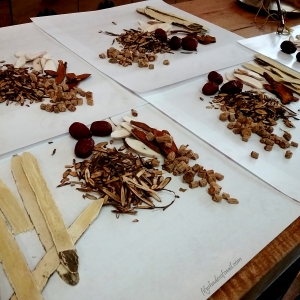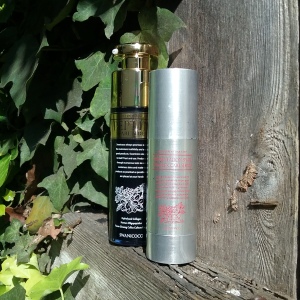Let’s talk ingredients! Only this time, instead of talking about all the wonderful things that our favorite ingredients can do, let’s talk about some of the times when those favored ingredients fail to do the thing. Because, let’s face it, no ingredient is a magic bullet that makes any skincare product great. Nope, not a single one. Not snail. Not propolis. And not even ginseng.
(I was inspired to write this post by Reddit Asian Beauty user /u/theeternalnoob, who commented thoughtfully on K-beauty’s ginseng craze and got me thinking hard about the role bloggers like me play in perpetuating ingredient hype. As skincare fanatics–and AB fanatics–we tend to be heavily ingredients-focused, but it’s as important to remember the limitations of fancy ingredients as it is to know their possible benefits. More important, in many cases.)

I’ll be focusing on extracts in this post, but some of my points also apply to actives.
The limitations of extracts in skincare
So you’ve learned about some of the many potential benefits of ginseng, snail, honey and propolis, or any other of the wide variety of fancy extracts that beauty brands like to feature. It’s exciting! It opens up a whole new world of products to try!!
It’s not necessarily a promise of greatness, not even when the ingredient in question is one that actually has credible research backing its effects!!! Isn’t that just the biggest boner killer!!!!

The major reason that an extract can’t be a reliable indicator of product effectiveness is simple: there is no standardization of extract concentration between different ingredient suppliers. Let’s take ginseng, for example. Brand A could be using a highly concentrated ginseng extract. Brand B, on the other hand, could be using an extract made from one lonely ginseng twig extracted into an industrial-sized tub of solvent. But the ingredient will look the same on both products’ labels.
That doesn’t even get into questions of the quality of the ginseng used to make the extracts in the first place. Here, the differences might be more subtle but still real. Different methods of cultivation and factors like soil quality and harvesting times and processes may influence the nutritional profile of a crop and presumably have a greater-than-zero effect on the final product. And there’s little to no way of knowing how the source of your fancy extract was farmed just by looking at the bottle.
Most brands don’t really acknowledge these concerns beyond maybe a blanket “we use high quality ingredients” statement. That is because most brands don’t have much control over the cultivation and extraction of the botanical ingredients they use. Most source their extracts from third party suppliers, so in a sense, they’re as much at the mercy of external and unknowable forces as we consumers are.
There are some exceptions, but be warned, the exceptions tend to cost a lot. One that comes to mind, because I received an hour-plus presentation on the topic last week, is Amorepacific.

During our trip to New York, the Snailcast girls and I met up with some reps from Sulwhasoo/Amorepacific/Laneige US HQ and spent time learning about the brand. Amorepacific products heavily feature green tea (camellia sinensis) extracts; Amorepacific claims to cultivate, harvest, and extract its green tea under strictly controlled conditions. Supposedly the leaves are picked using the left hand only to minimize damage, and the brand rep says there’s an extra-special secret garden to which only scientists have access. (I desperately want photos and video of this.)
It all sounds really really extra–but then again, Amorepacific price points are pretty extra, so I would expect brand storytelling around ingredient quality to be extra, too. (And I say this with the utmost respect and love, since I happen to be very fond of the AP products in my current testing lineup.)
My point (besides just wanting to share the “left hand picking only” story because WOW SERIOUSLY?!) is that while there are exceptions, generally you won’t be able to find information on the quality of any of the extracts used in your skincare. And the information you will find tends to come from brands, which want to cast their ingredients in the best light.
They could be picked with the left hand of a loving scientist, or carelessly torn from the ground with grindy-mashy farm equipment driven by the RIGHT HAND of an angry underpaid worker who cares little about the precious plants that will be converted into things that go on our faces. Ultimately, you don’t know. Which is why buying products based on a single ingredient isn’t usually a good idea.
The final point I want to make in this section is more general. In cosmetics, formulation is everything–a product could use the most potent and high-quality extracts available and still suck, for an infinite variety of reasons. It’s like the difference between Gordon Ramsay and someone whose cooking expertise stops at Stove Top stuffing. (Which is my favorite stuffing, but still.) Give them each the same premium ingredient–the results won’t be on the same level at all. Also that sounds like a challenge that should go on one of Gordon Ramsay’s many awesome TV shows.
In a skincare product, there might not be enough of the sexy extracts to make a difference. The extracts might be used in a generally unpleasant or ineffective formulation. There’s also good old YMMV–what works for my skin may not work for yours, and vice versa.
Meanwhile, a well formulated product with a seemingly nondescript ingredients list might turn out to be fantastic!
I’m not saying there’s no point to those headlining extracts many of us love. If there wasn’t, I wouldn’t be here–and I still get excited when I see them in a product. But it’s important to remember that no single ingredient is a magic bullet.
To hammer that point home, in part 2, I’ll take a look at a few products that I dislike despite their inclusion of ingredients I love. Stay tuned, because it’s going to be dragging time!

I work in retail selling nutritional supplements- it can be difficult explaining to customers why one product is considered to be of higher quality or potency than another even though the labels look very similar, and hence the difference in price. Especially when people are looking at extracts, antioxidants etc that are inherently more expensive like coQ10 and turmeric. I mean sometimes the higher price is truly meaningless, and some products will be pretty much the same no matter who makes them or what you pay for them, but often it reflects a higher standard of quality and sourcing.
LikeLike
Actually, I’ve seen similar levels of extra when I buy tea, so the AmorePacific pitch doesn’t surprise me. Also, now I want to visit the secret tea garden and have a cup of tea.
LikeLike
Hello
I recently discovered your blog and have been hooked (it 8am in uk, Saturday and I have been avidly reading your blog on my phone in bed for the last hour!)
I have similar skin concerns you write about, Asian skin, freckles/ dark/ sun spots and have been looking for ways to get my skin back to the way it was 10 years ago blemish/ freckled free. Im very lucky in the sense that wrinkles have not yet surfaced on my 30 yr old face.
I was wondering what your opinion is on Hydrafacials and if you have experienced this? There’s many claims and even more fans of this facial and it supposedly helps with sun spots and hyperpigmentation so would love your view on this.
Thanks so much and please keep posting i love your in depth skin science reviews on products
LikeLike